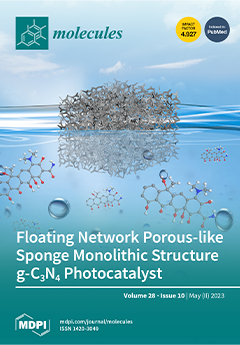The processing of
Citrus grandis Osbeck cv. Mato Peiyu (CGMP) fruits generates a considerable amount of waste, mainly the flavedo, albedo, and segment membrane; the generated waste yields severe environmental and economic challenges. In this study, we tried to reclaim some functional chemicals from the waste. Our data indicated that the essential oil content in the flavedo was 0.76–1.34%, with the major component being monoterpenes (93.75% in August, declining to 85.56% in November, including mainly limonene (87.08% to 81.12%) and others such as β-myrcene).
p-Synephrine (mg/100 g dry weight) declined accordingly (flavedo, 10.40 to 2.00; albedo, 1.80 to 0.25; segment membrane, 0.3 in August, 0.2 in September, and none since October). Polyphenols (in μg/g) included gallic acid (70.32–110.25, 99.27–252.89, and 105.78–187.36, respectively); protocatechuic acid (65.32–204.94, 26.35–72.35, and 214.98–302.65, respectively),
p-coumaric acid (30.63–169.13, 4.32–17.00, and 6.68–34.32, respectively), ferulic acid (12.36–39.36, 1.21–10.25, and 17.07–39.63, respectively), and chlorogenic acid (59.19–199.36, 33.08–108.57, and 65.32–150.14, respectively). Flavonoids (in μg/g) included naringin (flavedo, 89.32–283.19), quercetin (181.05–248.51), nobiletin (259.75–563.7), hesperidin, and diosmin. The phytosterol content (mg/100 g) was 12.50–44.00 in the flavedo. The total dietary fiber in the segment membrane was 57 g/100 g. The antioxidant activity against the DPPH
• and ABTS
+• free radicals was moderately high. In conclusion, the waste of CGMP fruits is worth reclaiming for essential oil,
p-synephrine, polyphenolics, and dietary fiber. Notably,
p-synephrine content (flavedo: <8 mg/100 g dry weight, albedo: <2.0, or segment membrane: <0.4 mg) can serve as a marker of the internal maturation of CGMP fruits.
Full article






